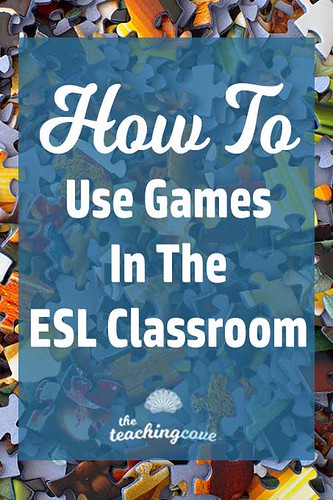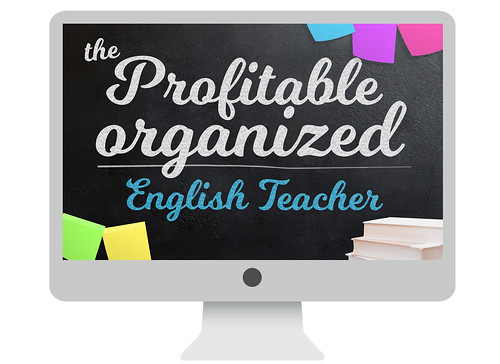Whether you teach children or adults, teaching ESL grammar and vocabulary in a fun and effective way can be so tough sometimes, can't it? Lesson planning for grammar concepts can definitely be a challenge.
Well, today's post is about how to deal with exactly that! I'm going to share my top 5 ways to use games in the ESL classroom.

If you've met me (over at The Teaching Cove), you know I LOVE using games to spice up learning. I also love the look on adult students' faces when they are expecting to spend the entire class listening to a lecture, rather than speaking (in an English as a second language class!).
Sometimes, they look at me like I'm a tiny bit insane.
Move? Who? Me?! I thought we were having a grammar lesson today.
You bet! We are, but we’re not going to be bored out of our minds copying grammar exercises from the textbook. (Note: I do think written grammar exercises provide valuable practice outside of class, but should be used sparingly in class itself).
Actually, one of my professors in the TESL program at McGill University had a three-part recipe for success for the ESL classroom that I find quite clever:
Water (hydration), Laughter, and Movement.
Games do a pretty good job of covering 2 of 3! If you are teaching younger ESL students, it’s not a bad idea to have water on hand, either.

5 Tips For Teaching With Games
So, I primarily use games in ESL teaching in three ways:
First, for grammar concepts:
Use games as review for concepts students have already studied. Don't try to introduce a concept using a game, as this gets frustrating for many students. At the very least, do a 10-minute intro to the grammatical concept before you start playing the game. Be sure to emphasize the purpose of the game. For example: “Yes, we’re here to have fun – but be sure you use the conditional tense in your answers”.
Second, for vocabulary development:
I often use games to help students learn new words or expressions, or review ones covered in units. This works especially well for review before an exam. Matching games (idioms to definitions for example) are often a hit with adults.
Third, for speaking fluency:
Well, working on speaking fluency is my favourite activity! (No surprise there; it’s the topic of my PhD). Use games to get the whole class speaking, not just the outgoing ones. This can be especially tough with shy adults or those who don't feel confident in their English skills.
Have students work in small groups (so you may need many copies of the game cards or game boards). Then, walk around as students play and be there to patiently coach struggling learners along. Be sure that every student has an opportunity to speak.
Ready for my top 5 tips for using games?
1. Games are Not Just For Kids
Now, you're going to face a lot of resistance to this one if you're teaching adults who are used to a lot of rote textbook work (like here in Spain, for example).
In fact, I start off the first class of every year giving them fair warning - I love games! This is an interactive class and I need you all to participate. It usually gets a bit of laughter out of the class, and it takes a few minutes for them to realize I’m serious.
2. Tailor Games To Grammatical Concepts and Levels
Before you start using games in class, be sure you understand the concept you want to teach, and your students’ level. The "level" part is key. There's nothing worse than using a fun game that's too difficult and having students end up frustrated, rather than laughing and having fun.
In fact, that happened to me the other day while teaching pronouns to 7-year-old twins in a private tutoring session.
So, I quickly simplified the game we were playing so the students only had to use one pronoun at a time (instead of choosing the correct option), and the girls started to have fun. It was a close call though! Remember to be flexible and adapt to your students’ level.
3. Teach, Play, Recap
Again, don't forget to teach the concept first! Whether you're using the game for vocabulary or grammar, do a quick review before you start.
Activities after you play the game are as important as the game itself. Be sure to have follow-up activities ready for the next class or early finishers, but also recap before the end of class. For example, if your students are doing a speaking activity in small groups, walk around the class and (quietly) take notes on their speech errors. Then, present a compiled list to the class so they can learn from each other’s mistakes.
4. Use Jigsaw Activities To Engage The Whole Class
If you have a large class, “jigsaw activities” are great games to use. These are activities where each small has a “piece” of the solution, such as a short paragraph of text in a story. For example, there may be four parts of the story, and four groups in your class (Groups A, B,C,D). All students in each group become “experts” on their portion. Then, students form new groups, with one member from each original group in the new group (ABCD). Next, they piece together the entire story. For more information on jigsaws, check out this site.
5. Use Word Games to teach Idioms, Puns, and Quotes
Finally, word games are fun ways to teach vocabulary, whether you’re teaching absolute beginners or advanced students. A simple matching activity to review vocabulary, or a memory-style card game where the matching answers are expressions and definitions (rather than two identical photos) works well.
3 of My Favourite Games:
1. Hangman (for Kids) - You’ll be surprised how much fun students have guessing letters of words they have learned!
2. Phrasal Verbs Story Game (Advanced)
Now, if you teach ESL, you know that phrasal verbs can be the source of a lot of anxiety for learners. Learning a handful of phrasal verbs at a time, and making them into fun, creative stories (in groups) is a great way to get students having fun. Also, it eases some of the frustration when students work together, with the challenge of using as many phrasal verbs as possible (from a given list) in their story.
3. Speaking Board Game (All Levels)
Create a board game worksheet with questions specifically using the tense you have been practicing (past, future, conditional, etc.) Simply having students roll the dice, land on a square and answer the question seems to liven up the classroom atmosphere. Again, be sure you play the role of a “monitor” and walk around, quietly noting down errors, so you can finish the lesson with a recap of common errors on the board. Depending on your error correction strategy, you may want to correct students as you hear errors made.
If you'd like worksheets for any of the above games, be sure to sign up for the Teaching Cove's free printables library to get your copy.
Also, if you'd like even more guidance to become a profitable, organized English teacher and perhaps set up your own part time or full time teaching biz, be sure to check out my new course here: The Profitable Organized English Teacher). It even includes access to an exclusive Facebook group, where I'm happy to help you one on one.
Happy Teaching!
Sapna Sehgal is a blogger, English teacher and linguist who runs The Teaching Cove, an educational blog with free teaching, motivational, and organizational resources. She has been teaching English and ESL classes and tutoring privately for over 15 years. Originally from Canada, Sapna now lives in Barcelona, Spain. Sapna has recently released her first course, The Profitable Organized English Teacher, to help educators set up and run successful part-time or full-time tutoring businesses without feeling overwhelmed.

